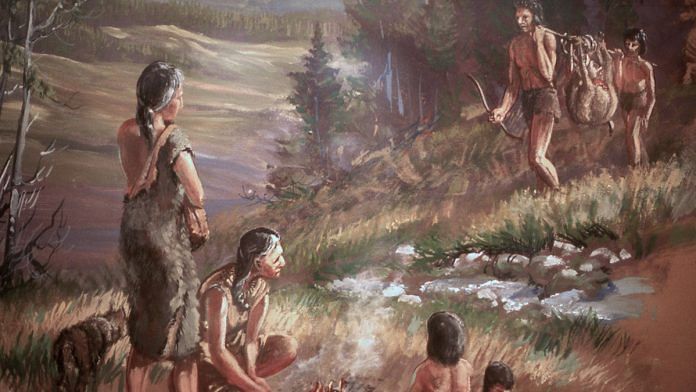Bengaluru: A new study suggests that northern Botswana, specifically the region south of the Zambezi river, is most likely the ancestral homeland of all humans.
In the study published in Nature, a group of Australian, Namibian, South African and South Korean researchers combined multiple fields of anthropology, such as ethno-linguistics (relationship between language and ethnic groups), genetics, climatic reconstructions and more, to conclude that our first Homo sapiens ancestors emerged from Makgadikgadi-Okavango, the palaeo-wetland of southern Africa.
Anatomically modern humans (AMH) first walked on Earth roughly 200,000 years ago in Africa. AMH is the phrase used to distinguish Homo sapiens from other extinct hominins such as Neanderthals and Denisovans.
The exact location of the first evolved AMH was unclear before the study — fossil records seemed to indicate it was in eastern Africa, while genetic analysis suggested southern Africa.
Also read: There’s a new problem — the term ‘modern humans’ doesn’t cut it any more
The research
This study is strongly based on genetics, specifically on mitochondrial DNA called mitogenomes. The researchers sequenced mitogenomes of 198 southern Africans and a total of 1217 mitogenomes were analysed. The team also ethno-linguistically classified these individuals as either KhoeSan — those who practice foraging and have a click in their languages who were underrepresented in the genetic database — or non-KhoeSan.
The researchers used phylogenetic analysis (studying the genes to determine genetic evolution) along with language families to reconstruct geographical population dispersals and their common ancestry. This determined that the first genetic lineage settled in the southwest region of the Zambezi river and diverged from here just 60,000 to 70,000 years ago. Archaeological evidence suggests that modern cognitive skills had already started to develop among these humans.
Also read: Humans (or something similar) were always destined to walk the Earth
Population dispersal
The paper also states that the Kalahari region in the greater Zambezi river basin had a critical role in shaping the emergence and pre-history of AMHs. The region, which is today made up of salt pans and is considered a semi-arid desert, was once the seat of a gigantic lake twice the size of Lake Victoria — Africa’s largest lake and the world’s largest tropical lake.
This great lake began to break up 2,00,000 years ago and created sprawling wetlands. This brought fertility and greenery to the region, and the AMHs settled in this lushness for at least 70,000 years.
Later, the climate changed and humans started dispersing and moving away.
“Today, the harsh Kalahari climate and oxygen-rich salt pans are not ideal for fossil and pollen preservation, respectively,” write the researchers.
“However, period-relevant lithic artefacts [stone] are documented from the Makgadikgadi pans and surroundings, while palynology [study of pollen] suggests that this region was once a grassland and forest biome,” they add.
Also read: 60% of life on Earth is lost, and 6 other science discoveries of 2018
Existing theories on human migration are either ‘pull’ scenarios, where more attractive pastures caused humans to move towards them, or ‘push’ scenarios, where lack of food or dry conditions drove humans out of Africa.
The researchers reconstructed the paleo-climate of the region, especially the availability of water and monsoons, to arrive at the accurate reason for the migration from Kalahari.
To do this, they compared four existing sets of data on paleo-climate that factored in parameters like the earth’s wobble on its axis as it goes around the sun, which then resulted in natural climate change. From this data they concluded that favourable conditions enabled migration.
The hydro-climatic variations brought increased humidity and ‘green corridors’ in the dry regions around the lake. The researchers were able to identify the sequence of human dispersal through archaeological sites. These sites indicate that as wetlands state drying up, humans first migrated northeast of these wetlands, then southwest, eventually moving out of Africa and spreading across the world, intermingling with other hominins like Neanderthals and Denisovans.
The controversy
The study has been criticised for being too narrow and for ignoring other forms of non-genetic evidence, like the 3,15,000-year-old fossil remains of an AMH found in Jebel Irhoud, Morocco. The researchers clarified that they were only interested in genetically tracing human ancestry. The fossils from Jebel Irhoud do not contain any DNA to analyse.
The methodology of analysis itself has also come under criticism – many others have pointed out that mitogenomes are not entirely representative of a human’s genetic makeup. For example, nearly all humans today have Neanderthal DNA but this doesn’t show up in the mitochondria, only in the cell nucleus.
There could also be multiple ancestral homelands if the fact that Homo sapiens could have evolved independently in multiple places is taken into consideration. The study authors accept this in the paper.



